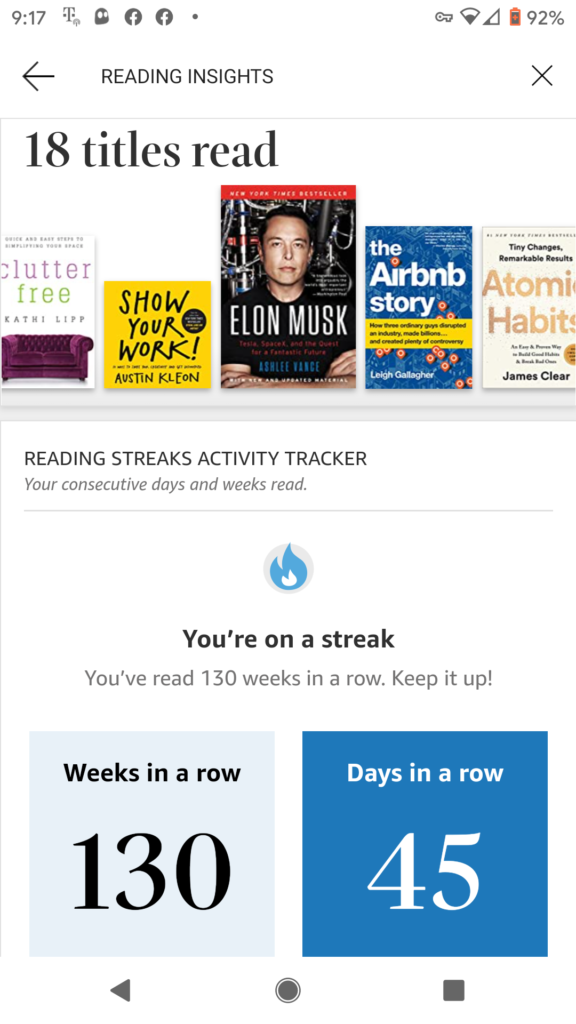
I have enjoyed reading my entire life, since I was a toddler. For the past couple years, I have typically had at least two books going at the same time: one for learning and one for pleasure. This year was no different.
I was hoping to read over 40 books in 2022, but I counted the Legacy War 9-book series as a single book and several books were pretty massive, taking a while to finish. Regardless, I’m pretty happy with the reading I achieved this past year and I’m looking forward to another great reading year in 2023. I’ve already built quite a backlog in my Kindle library and my Amazon wishlist.
Here are the books I read in 2022:
- Switch: How to Change Things When Change Is Hard, by Chip Heath and Dan Heath (Started 2021 – COMPLETED)
- Sprinting Though No Man’s Land: Endurance, Tragedy, and Rebirth in the 1919 Tour De France, by Adin Dobkin (Started 2021 – COMPLETED)
- Feedback (First Contact), by Peter Cawdron
- Invent and Wander: The Collected Writings of Jeff Bezos, by Jeff Bezos (in progress)
- All Systems Red: The Murderbot Diaries (book 1), by Martha Wells
- The Second Ship (The Rho Agenda Book 1), by Richard Phillips
- The Storyteller: Tales of Life and Music, by Dave Grohl
- Legacy War: The Complete Series Books 1-9, by John Walker
- Boundaries: When To Say Yes, How To Say No To Take Control Of Your Life (updated and expanded edition), by Henry Cloud and John Townsend
- The Language of Emotional Intelligence: The Five Essential Tools For Building Powerful and Effective Relationships, by Jeanne Segal
- The Filmmaker’s Handbook: A Comprehensive Guide for the Digital Age: Fifth Edition, by Steven Ascher, Edward Pincus (in progress – 15%)
- Making Movies, by Sidney Lumet
- The Filmmaker’s Eye: Learning (and Breaking) the Rules of Cinematic Composition, by Gustavo Mercado
- Deep Work: Rules for Focused Success in a Distracted World, by Cal Newport
- On the Meldon Plain (The Fourline Trilogy Book 2), by Pam Brondos (in progress)
- The Last Remnant (The Fourline Trilogy Book 3), by Pam Brondos
- Cryptonomicon, by Neal Stephenson
- Chasing Space: An Astronaut’s Story of Grit, Grace, and Second Chances, by Leland Melvin
- Artificial Condition: The Murderbot Diaries (book 2), by Martha Wells
- Rogue Protocol: The Murderbot Diaries (book 3), by Martha Wells
- Exit Strategy: The Murderbot Diaries (book 4), by Martha Wells
- Liftoff: Elon Musk and the Desperate Early Days That Launched SpaceX, by Eric Berger
- DODO, by Neal Stephenson
- Chasing Failure: How Falling Short Sets You Up For Success, by Ryan Leak
- Influencer: Building Your Personal Brand in the Age of Social Media, by Brittany Hennessey
- Network Effect: The Murderbot Diaries (book 5), by Martha Wells
- Tribes: We Need You To Lead Us, by Seth Godin
- The Obstacle Is The Way: The Timeless Art of Turning Trials Into Triumph, by Ryan Holiday
- Fugitive Telemetry: The Murderbot Diaries (book 6), by Martha Wells
- Into the Black: Remastered Edition (Odyssey One Book 1), by Evan Currie
- Crushing It: How Great Entrepreneurs Build Their Business And Influence – And How You Can, Too, by Gary Vaynerchuck
- Sandworm: A New Era of Cyberwar and the Hunt for the Kremlin’s Most Dangerous Hackers, by Andy Greenberg (in progress – 49%)
- One Million Followers, Updated Edition: How I Built a Massive Social Following in 30 Days, by Brendan Kane (in progress – 10%)
- Aliens: Colonial Marines Technical Manual, by Lee Brimmicombe-Wood (in progress – 10%)
Of the 34 books on my 2022 list:
- 2 were started in 2021 and completed in 2022
- 4 are still in progress
- 28 were started and completed in 2022
- 1 “book” was actually a series of 9 books (1280 pages total)
- Several were significantly longer than average – i.e., 700+ pages (e.g., #8, 11, 17, 23, possibly others)
- Most were in Amazon Kindle format, though some were hardcopy
- Most were purchases or gifts, though at least one was a library loan and a few were “free” via Amazon Prime Reading






